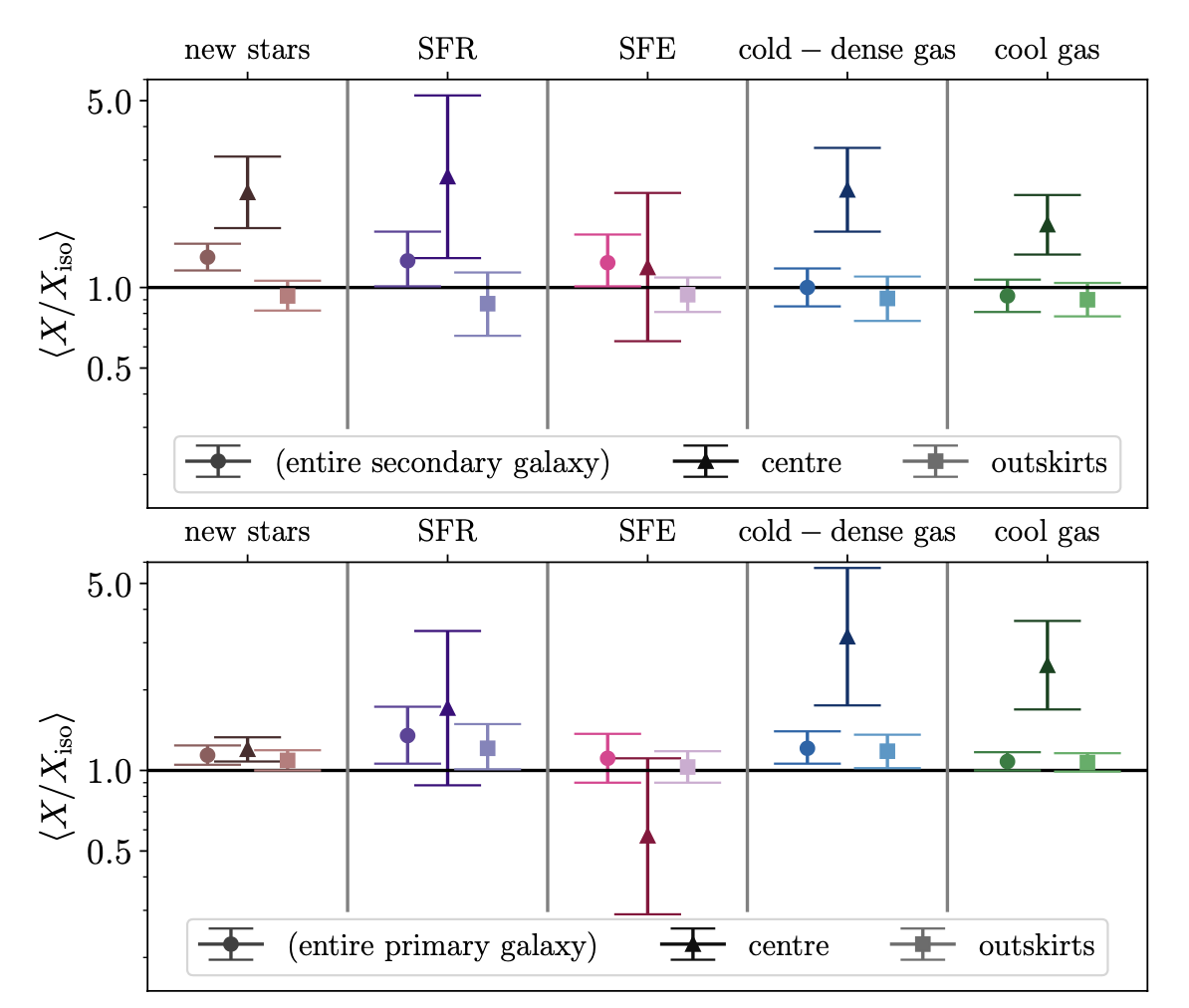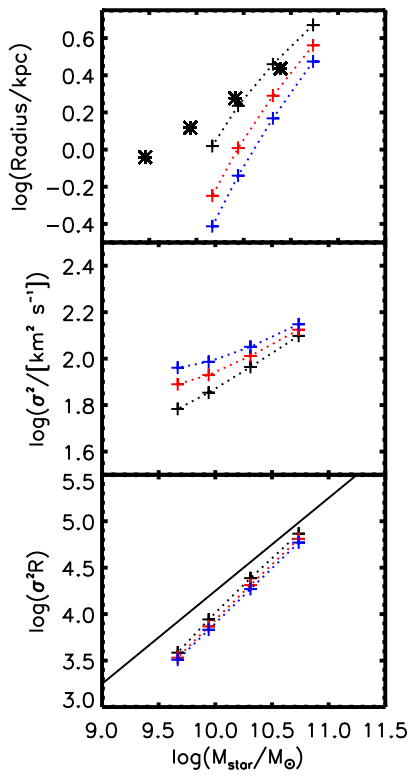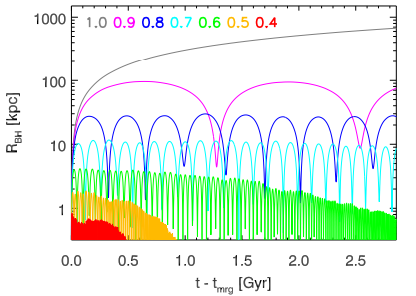Title: Spatially resolved star formation and fuelling in galaxy interactions
Authors: Jorge Moreno, Paul Torrey, Sara L. Ellison, David R. Patton, Connor Bottrell, Asa F. L. Bluck, Maan H. Hani, Christopher C. Hayward, James S. Bullock, Philip F. Hopkins and Lars Hernquist
First Author’s Institution: Department of Physics and Astronomy, Pomona College, Claremont, CA 91711, USA
Status: Accepted to MNRAS. Open access on Arxiv.
Galaxy mergers are a key aspect of galaxy evolution and can significantly affect star formation. In a galaxy merger, the centers of the galaxies pass near each other (called a pericenter) twice before coalescing. During the merger, star forming material gets funneled to the center of the galaxy, enhancing star formation and triggering feedback mechanisms.
The time between first and second pericenter is the “galaxy-pair” stage, when the two galaxies are still distinct but interacting via close encounters. Few studies of star formation focus on the pre-merged galaxy pairs, but the effects from interactions at this stage are expected to be long lasting. The author’s of today’s paper use galaxy merger simulations to study interactions in galaxy pairs. They use idealized, rather than cosmological, simulations to obtain high enough spatial resolution to study star formation and feedback processes at the parsec scale. The simulations employ the “Feedback In Realistic Environments-2” (FIRE-2) physics models and include 24 major mergers with different orbital configurations.
Effects of interactions in individual mergers
To start, the authors focus on a particular galaxy merger which they call their fiducial run. The high spatial resolution allows the author’s to differentiate the effects of interaction in the two individual galaxies — the larger primary galaxy and the smaller secondary galaxy. Figure 1 below shows snapshots of the fiducial run for the secondary galaxy, as well as a comparable isolated galaxy (the simulation is also available as a video!).
The galaxy-pair stage lasts for less than 2.5 Gyrs after the first pericenter. During this time, the secondary galaxy in the merger develops tidal tails, as well as a high concentration of gas in the center of the galaxy (shown as a small white circle in Figure 1). These effects are not seen in the isolated galaxy, though the effects are reduced by the end of the stage.

Figure 1. Top panel shows the distance between the primary and secondary galaxy for different time periods in galaxy interaction. The “galaxy-pair” stage is divided into three different periods: early, intermediate and late. Middle panel shows snapshots of the gas density in the secondary galaxy during the three time periods. Bottom panel shows the gas density for an isolated galaxy not undergoing a merger. (Adapted from Figure 1 in the paper).
For this fiducial run, the authors look at how different ratios related to star formation evolve over time: mass of new stars, star formation rate (SFR), star formation efficiency (SFE), mass of cold-dense gas, and mass of cool gas. The ratios are calculated between the merging galaxies and the isolated galaxy. The authors find that during the early period, the mass of new stars in the center of the secondary galaxy increases due to an increased SFR, which in turn is caused by an increase in SFE and availability of cool and cold gas.
Average effects of interactions
Given the timescale of the simulations (5 Myrs), it would be difficult to focus on all 24 mergers individually. Instead, the authors measure the average ratios of the five quantities for the entire sample. Figure 2 shows the average ratios for the secondary and primary galaxies, separated by region (center, outskirts, entire galaxy).

Figure 2. Top panel: For the secondary galaxy, ratios of new stars (mass), SFR, SFE, cold-dense gas (mass), and cool gas (mass), with respect to the isolated galaxy. The ratios are presented for three different regions in the galaxy as different symbols: circles (entire galaxy, < 10 kpc), triangles (center of the galaxy, < 1 kpc), squares (outskirts, 1-10 kpc). Bottom panel: Same as top panel but for the ratios between the primary and isolated galaxies. (Figure 5 in the paper).
On average, the secondary galaxies have 30% more mass in new stars than the isolated galaxies. In the center of the galaxies, that increases to 130%. Star formation rate is also enhanced relative to the isolated galaxy (25%), particularly in the center (160%). These effects are not seen in the outskirts of secondary galaxies. Since the ratio of cold-dense gas and cool gas are close to 1 for the entire galaxy (blue and green circles), it’s possible that the increased star formation rate is due to increased efficiency in forming stars (pink circle), and not due to more availability of material.
On the other hand, for primary galaxies, the enhancement in mass of new stars is relatively similar in all regions of the galaxy, and much less than the enhancement seen in the secondary galaxy. This seems to be driven by more availability of cold-dense gas, rather than increased efficiency like in secondary galaxies.
What’s going on in the central region?
The central region (~ 1 kpc) of merging galaxies exhibits the most enhancement in star formation compared to isolated galaxies. To see if this is driven by increased star formation efficiency or increased amounts of star forming material requires more careful consideration. Figure 3 below shows the ratio of SFE vs ratio of mass of cold-dense gas for all mergers, color coded by SFR ratio.

Figure 3. Left: For the secondary galaxy and isolated galaxy, the ratio of SFE vs ratio of mass of cold-dense gas, color coded by the ratio of SFR. The 2D histogram is divided by two lines that define regions of enhanced vs suppressed SFR, and fuel vs efficiency driven. Right: Same 2D histogram for the primary galaxy. (Figure 9 in the paper).
First, the authors ask whether the star formation rate is enhanced (blue) or suppressed (red) and then whether this is efficiency-driven, or fuel-driven. They find that for both secondary and primary galaxies, most of the SFR enhancement is fuel-driven, while SFR suppression is efficiency-driven. However, for the secondary galaxy, the most enhanced SFR (darkest blue) is driven by efficiency.
Today’s paper marks the largest galaxy merger simulation at parsec scales. This high spatial resolution allows the study of what drives star formation during galaxy-pair interactions, particularly at the central regions that experience the most enhanced star formation.
Astrobite edited by: Jamie Wilson
Featured image credit: Moreno et al. 2020




